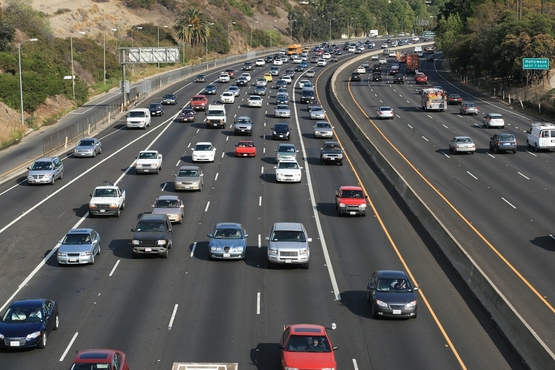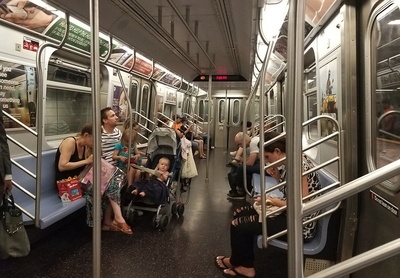 Cars on the roads are America's true mass transportation. |
THERE IS a subway station around the corner from my house, and another one two blocks from where I work. Taking the train every morning might be impractical for some people, but for me it could hardly be simpler. From my front door to the subway platform is a two-minute walk — 90 seconds if I hustle. If anybody has an easy commute to work on mass transit, I do.
But I don't commute on mass transit. I don't want to. The subway may be close — but the car in my driveway is closer. Unlike the subway, my car is ready whenever I am. Unlike the subway, my car goes only where I need to go and stops only where I want to stop. Unlike the subway, my car enables me to run an errand on the way to work, or stop at Starbucks for a cup of coffee. And unlike the subway, my car is private — no one comes along for the ride unless I extend an invitation.
Are my reasons petty? Is it selfish and irresponsible of me to be putting another automobile on the road every day, burning gasoline and taking up space, when I could so readily take the train instead?
The car-haters would surely say so, and Lord knows there are plenty of them, city planners and social critics and environmental activists forever hectoring us about the benefits of public transportation and the costs of automobile traffic — especially of commuters driving solo. Frequently they do more than hector. They lobby for increased government spending on mass transit. They demand steep hikes in the gasoline tax. They reserve highway lanes for buses and carpoolers. They mandate yearly auto inspections. They impose burdensome parking bans. In short, if it makes driving more difficult, they're for it.
For all their sway with editorialists and policymakers, however, the anticar critics have gotten nowhere with the public. According to Peter Samuel, editor of Toll Roads (an independent newsletter on turnpikes, bridges, and tunnels), federal and state governments have spent 10 times as much on mass transit, per person-mile, as they have on urban highways.
"Yet in disregard of the planners," Samuel writes, "and in spite of increased mass transit supply, the nation's commuters have steadily deserted mass transit for private cars." Billions of public dollars have gone into expanding mass transit, but passenger ridership hasn't increased. Between 1983 and 1993, mass transit capacity climbed 20 percent. In the same decade, the rate at which passengers use mass transit fell 16 percent.
Why? Because the vast majority of commuters would rather drive. Despite the hassles. Despite the costs. Despite the added responsibility. Despite the heavily subsidized (and therefore cheaply priced) mass transit alternative. In 1990, only 5.3 percent of commuters took public transportation to work — and that was down from 6.2 percent in 1980. The glaring truth, as Samuel notes, is that "cars on the roads provide America's mass transportation, while 'mass transit' caters to a small and diminishing minority."
It is something of a cliche to attribute Americans' resistance to mass transit to their "love affair with the car." It's also something of a put-down. The implication is that if only we weren't so irrationally attached to our Thunderbirds and Jeep Cherokees, we would choose a more sensible way to get to work.
In a passage quoted by Samuel, transportation scholar Alan Pisarski skewers that bromide. "Americans love their automobiles about as much as they love their microwave ovens. They have them, and they use them, because they are very efficient tools. They are time-saving devices."
 Though heavily subsidized and avidly promoted by government, mass transit is snubbed by the vast majority of American commuters. |
It isn't only Americans who think so. Car ownership is skyrocketing in Europe, in spite of transportation policies that are heavily skewed against cars and drivers. As far back as 1987, per-capita ownership of automobiles in Western Europe was growing three times faster than in the United States. UCLA professor James Q. Wilson writes in the July Commentary that "if people can afford it, they will want to purchase convenience, flexibility, and privacy. These facts are as close to a Law of Nature as one can get in the transportation business. When the industrial world became prosperous, people bought cars. It is unstoppable."
US motorists pay a heavy price for the comfort and autonomy of car-driving. In gasoline taxes, auto sales taxes, registration fees, and tolls, they cough up some $115 billion a year — far more than the $76 billion the government spends to build and maintain the roads they drive on.
By contrast, passengers who use public transportation pay only a fraction of what their ride really costs. In Boston, where the first subway in America was opened 100 years ago next month, fares on the MBTA cover only 22 percent of costs. Which is to say, MBTA riders enjoy a 78 percent subsidy — most of it taken from the wallets of automobile owners.
This is — let's be blunt — welfare for mass transit users. And what has it gotten us? Buses and subways that keep getting emptier even as highways grow increasingly congested. However much the car-bashers might wish otherwise, public transportation is not the wave of the future. It is the wave of the past. The overwhelming majority of Americans don't want the state to arrange their transportation, and they don't want to pay for the handful who do. They just want to drive themselves to work.
(Jeff Jacoby is a columnist for The Boston Globe).
-- ## --
Follow Jeff Jacoby on Twitter.
Discuss his columns on Facebook.
Want to read more? Sign up for "Arguable," Jeff Jacoby's free weekly email newsletter.

